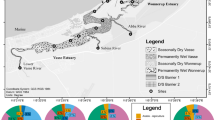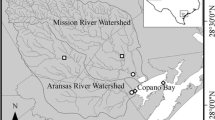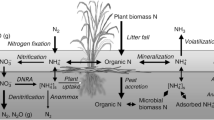Abstract
Freshwater estuaries may be important control points but have received limited research attention, emblematic of a general under-appreciation of these ecosystems and the services they provide. These ecotone environments exist at the interface of rivers flowing into large lakes, where seiches cause mixing of lotic and lentic waters within flooded river deltas. We assessed the dissolved inorganic nitrogen (DIN) retention and processing controls in the Saint Louis River Estuary (SLRE), which receives inputs from rivers, urban sources, and Lake Superior. Nitrate (NO3–N) was the dominant form of DIN and was consistently highest in the lower estuary due to seiche-delivered Lake Superior water and nitrification of ammonium from urban sources. The estuary transitioned from a net NO3–N source during high flows to a net sink during summer baseflow conditions. NO3–N availability controlled site-specific denitrification rates while sediment organic matter explained the spatial pattern in denitrification potential. As the estuary shifted from a riverine state to one with more lake influence, seiches delivered Lake Superior NO3–N to the lower portion of the estuary, alleviating the final denitrification control and activating the estuary’s ‘denitrification pump’. This amplified removal condition is maintained by critically delivered NO3–N during periods of warm temperatures and long residence times. Often these controls are unsynchronized in streams where NO3–N is typically lowest during summer baseflow. Similar ephemeral biogeochemical processes are likely found within other seiche-prone lakes where organic-rich sediments accumulate at river mouths and are supplied with chemically distinct lake water during low flow periods.









Similar content being viewed by others
References
Barnes RT, Raymond PA (2010) Land-use controls on sources and processing of nitrate in small watersheds: insights from dual isotopic analysis. Ecol Appl 20:1961–1978
Baron JS, Hall EK, Nolan BT, Finlay JC, Bernhardt ES, Harrison JA, Chan F, Boyer EW (2012) The interactive effects of excess reactive nitrogen and climate change on aquatic ecosystems and water resources of the United States. Biogeochemistry 114:71–92
Beletsky D, Saylor JH, Schwab DJ (1999) Mean circulation in the Great Lakes. J Great Lakes Res 25:78–93
Bellinger BJ, Jicha TM, Lehto LP, Seifert-Monson LR, Bolgrien DW, Starry MA, Angradi TR, Pearson MS, Elonen C, Hill BH (2014) Sediment nitrification and denitrification in a Lake Superior estuary. J Great Lakes Res 40:392–403
Bonaglia S, Deutsch B, Bartoli M, Marchant HK, Brüchert V (2014) Seasonal oxygen, nitrogen and phosphorus in benthic cycling along an impacted Baltic Sea estuary: regulation and spatial patterns. Biogeochemistry 119:139–160
Bouchard V (2007) Export of organic matter from a coastal freshwater wetland to Lake Erie: an extension of the outwelling hypothesis. Aquat Ecol 41:1–17
Burgin AJ, Hamilton SK (2007) Have we overemphasized the role of denitrification in aquatic ecosystems? A review of nitrate removal pathways. Front Ecol Environ 5:89–96
Carpenter SR (2008) Phosphorus control is critical to mitigating eutrophication. Proc Natl Acad Sci 105:11039–11040
Czuba CR, Fallon JD, Kessler EW (2012) Floods of June 2012 in northeastern Minnesota: U.S. Geological Survey Scientific Investigations Report 2012–5283
Einarsson E, Lowe B (1968) Seiches and set-up on Lake Winnipeg. Limnol Oceanogr 13:257–271
Elser JJ, Bracken MES, Cleland EE, Gruner DS, Harpole WS, Hillebrand H, Ngai JT, Seabloom EW, Shurin JB, Smith JE (2007) Global analysis of nitrogen and phosphorus limitation of primary producers in freshwater, marine and terrestrial ecosystems. Ecol Let 10:1135–1142
Enoksson V (1993) Nutrient recycling by coastal sediments: effects of added algal material. Mar Ecol Prog Ser 92:245–254
Erisman JW, Galloway JN, Seitzinger S, Bleeker A, Dise NB, Petrescu AMR, Leach AM, de Vries W (2013) Consequences of human modification of the global nitrogen cycle. Phil Trans R Soc B 368:20130116
Finlay JC, Sterner RW, Kumar S (2007) Isotopic evidence for in-lake production of accumulating nitrate in Lake Superior. Ecol Appl 17:2323–2332
Finlay JC, Small GE, Sterner RW (2013) Human influences on nitrogen removal in lakes. Science 342:247–250
Fitzpatrick ML, Long DT, Pijanowski BC (2007) Exploring the effects of urban and agricultural land use on surface water chemistry, across a regional watershed, using multivariate statistics. Appl Geochem 22:1825–1840
Forshay KJ, Stanley EH (2005) Rapid nitrate loss and denitrification in a temperate river floodplain. Biogeochemistry 75:43–64
Foster SQ, Fulweiler RW (2014) Spatial and historic variability of benthic nitrogen cycling in an anthropogenically impacted estuary. Front Mar Sci 1:1–16
Fulweiler RW, Heiss EM (2014) A decade of directly measured sediment N2 fluxes: what can Narragansett Bay tell us about the global ocean nitrogen budget? Oceanography 27:184–195
Galloway JN, Dentener FJ, Capone DG, Boyer EW, Howarth RW, Seitzinger SP, Asner GP, Cleveland CC, Green PA, Holland EA, Karl DM, Michaels AF, Porter JH, Townsend AR, Vorosmarty CJ (2004) Nitrogen cycles: past, present, and future. Biogeochemistry 70:153–226
Gardner JT, English M, Prowse TD (2006) Wind-forced seiche events on Great Slave Lake: hydrologic implications for the Slave River Delta, NWT, Canada. Hydrol Process 20:4051–4072
Garnier J, Cébron A, Tallec G, Billen G, Sebilo M, Martinez A (2006) Nitrogen behaviour and nitrous oxide emission in the tidal Seine river estuary (France) as influenced by human activities in the upstream watershed. Biogeochemistry 77:305–326
Giblin AE, Tobias CR, Song B, Weston N, Banta GT, Rivera-Monroy VH (2013) The importance of dissimilatory nitrate reduction to ammonium (DNRA) in the nitrogen cycle of coastal ecosystems. Oceanography 26:124–131
Groffman PM, Holland EA, Myrold DD, Robertson GP, Zou X (1999) Denitirification. In: Robertson GP, Bledsoe CS, Coleman DC, Sollins P (eds) Standand soil methods long-term ecological research. Oxford University, New York, pp 272–288
Groffman PM, Altabet MA, Böhlke JK, Butterbach-Bahl K, David MB, Firestone MK, Giblin AE, Kana TM, Nielsen LP, Voytek MA (2006) Methods for measuring denitrification: diverse approaches to a difficult problem. Ecol Appl 16:2091–2122
Herdendorf CE (1990) Great Lakes estuaries. Estuaries 13:493–503
Hill AR (1993) Base cation chemistry of storm runoff in a forested headwater wetland. Water Resour Res 29:2663–2673
Hoellein TJ, Bruesewitz DA, Richardson DC (2013) Revisiting Odum (1956): a synthesis of aquatic ecosystem metabolism. Limnol Oceanogr 58:2089–2100
Hoffman JC, Peterson GS, Cotter AM, Kelly JR (2010) Using stable isotope mixing in a Great Lakes coastal tributary to determine food web linkages in young fishes. Estuar Coasts 33:1391–1405
Howarth R, Swaney D, Billen G, Garnier J, Hong B, Humborg C, Johnes P, Mörth C-M, Marino R (2012) Nitrogen fluxes from the landscape are controlled by net anthropogenic nitrogen inputs and by climate. Front Ecol Environ 10:37–43
Johnston CA, Bridgham SD, Schubauer-Berigan JP (2001) Nutrient dynamics in relation to geomorphology of riverine wetlands. Soil Sci Am J 65:557–577
Kabeya N, Kubota T, Shimizu A, Nobuhiro T, Tsuboyama Y, Chann S, Tith N (2008) Isotopic investigation of river water mixing around the confluence of the Tonle Sap and Mekong rivers. Hydrol Process 22:1351–1358
Knuth ML, Kelly JR (2011) Denitrification rates in a Lake Superior coastal wetland. Aquat Ecosyst Health Manag 14:414–421
Koop-Jakobsen K, Giblin AE (2010) The effect of increased nitrate loading on nitrate reduction via denitrification and DNRA in salt marsh sediments. Limnol Oceanogr 55:789–802
Kumar S, Sterner RW, Finlay JC, Brovold S (2007) Spatial and temporal variation of ammonium in Lake Superior. J Great Lakes Res 33:581–591
Larson JH, Trebitz AS, Steinman AD, Wiley MJ, Mazur MC, Pebbles V, Braun HA, Seelbach PW (2012) Great Lakes rivermouth ecosystems: scientific synthesis and management implications. J Great Lakes Res 39:513–524
Lewis WM, Wurtsbaugh WA, Paerl HW (2011) Rationale for control of anthropogenic nitrogen and phosphorus to reduce eutrophication of inland waters. Environ Sci Technol 45:10300–10305
Loken LC (2014) Hydrologic and biotic controls of nitrogen cycling in a Lake Superior freshwater estuary. MS Thesis, University of Wisconsin, Madison
McCarthy MJ, Gardner WS, Lavrentyev PJ, Moats KM, Frank J, Klarer DM (2007) Effects of hydrological flow regime on sediment-water interface and water column nitrogen dynamics in a Great Lakes coastal wetland (Old Woman Creek, Lake Erie). J Great Lakes Res 33:219–231
Meyers PA, Teranes JL (2001) Sediment organic matter. In: Last WM, Smol JP (eds) Tracking environmental change using lake sediments, vol 2., Physical and geochemical methods. Kluwer, Dordrecht, pp 239–269
Middelburg JJ, Nieuwenhuize J (2001) Nitrogen isotope tracing of dissolved inorganic nitrogen behaviour in tidal estuaries. Estuar Coast Shelf Sci 53:385–391
Morrice JA, Kelly JR, Trebitz AS, Cotter AM, Knuth ML (2004) Temporal dynamics of nutrients (N and P) and hydrology in a Lake Superior coastal wetland. J Great Lakes Res 30:82–96
Morrice JA, Trebitz AS, Kelly JR, Sierszen ME, Cotter AM, Hollenhorst T (2011) Determining sources of water to Great Lakes coastal wetlands: a classification approach. Wetlands 31:1199–1213
Mortimer CH, Fee EJ (1976) Free surface oscillations and tides of Lakes Michigan and Superior. Philos Trans R Soc Lond B 281:1–61
Mulholland PJ, Tank JL, Sanzone DM, Wollheim WM, Peterson BJ, Webster JR, Meyer JL (2000) Nitrogen cycling in a forest stream determined by a 15N tracer addition. Ecol Monogr 70:471–493
Nixon SW (1981) Remineralization and nutrient cycling in coastal marine sediments. In: Nielsen B, Cronin L (eds) Estuaries and nutrients. Humana Press, New Jersey, pp 111–138
Nixon SW, Ammerman JW, Atkinson LP, Berounsky VM, Billen G, Voicourt WC, Boynton WR, Church TM, Ditoro DM, Elmgren R, Garber JH, Giblin AE, Jahnke RA, Owens NJP, Pilson MEQ, Seitzinger SP (1996) The fate of nitrogen and phosphorus at the land-sea margin of the North Atlantic Ocean. Biogeochemistry 35:141–180
Ohte N, Sebestyen SD, Kendall C, Shanley JB, Wankel SD, Doctor DH, Boyer EW (2004) Tracing sources of nitrate in snowmelt runoff using a high-resolution isotopic technique. Geophys Res Lett 31:L21506. doi:10.1029/2004GL020908
Pattinson SN, Garcia-Ruiz R, Whitton BA (1998) Spatial and seasonal variation in denitrification in the Swale-Ouse system, a river continuum. Sci Total Environ 210:289–305
Pellerin BA, Saraceno JF, Shanley JB, Sebestyen SD, Aiken GR, Wollheim WM, Bergamaschi BA (2012) Taking the pulse of snowmelt: in situ sensors reveal seasonal, event and diurnal patterns of nitrate and dissolved organic matter variability in an upland forest stream. Biogeochemistry 108:183–198
Peterson BJ, Wollheim WM, Mulholland PJ, Webster JR, Meyer JL, Tank JL, Martí E, Bowden WB, Valett HM, Hershey AE, McDowell WH, Dobbs WK, Hamilton SK, Gregory S, Morrall DD (2001) Control of nitrogen export from watersheds by headwater streams. Science 292:86–90
Philips EJ, Cichra M, Aldridge FJ, Jembeck J, Hendrickson J, Brody R (2000) Light availability and variations in phytoplankton standing crops in a nutrient-rich blackwater river. Limnol Oceanogr 45:916–929
Piña-Ochoa E, Álvarez-Cobelas M (2006) Denitrification in aquatic environments: a cross-system analysis. Biogeochemistry 81:111–130
Richardson WB, Strauss EA, Bartsch LA, Monroe EM, Cavanaugh JC, Vingum L, Soballe DM (2004) Denitrification in the Upper Mississippi River: rates, controls, and contribution to nitrate flux. Can J Fish Aquat Sci 61:1102–1112
Roach WJ, Grimm NB (2011) Denitrification mitigates N flux through the stream–floodplain complex of a desert city. Ecol Appl 21:2618–2636
Saint Louis River Alliance (2013) Saint Louis River Aliance. http://stlouisriver.org/. Accessed 9 March, 2013
Schindler DW, Hecky RE, Findlay DL, Stainton MP, Parker BR, Paterson MJ, Beaty KG, Lyng M, Kasian SEM (2008) Eutrophication of lakes cannot be controlled by reducing nitrogen input: results of a 37-year whole-ecosystem experiment. Proc Natl Acad Sci 105:11254–11258
Seitzinger SP, Nielsen LP, Caffrey J, Christensen PB (1993) Denitrification measurements in aquatic sediments: a comparison of three methods. Biogeochemistry 23:147–167
Seitzinger SP, Harrison JA, Böhlke JK, Bouwman AF, Lowrance R, Peterson B, Tobias C, Van Drecht G (2006) Denitrification across landscapes and waterscapes: a synthesis. Ecol Appl 16:2064–2090
Sierszen ME, Morrice JA, Trebitz AS, Hoffman JC (2012) A review of selected ecosystem services provided by coastal wetlands of the Laurentian Great Lakes. Aquat Ecosyst Health Manag 15:92–106
Small GE, Bullerjahn GS, Sterner RW, Beall BFN, Brovold S, Finlay JC, McKay RML, Mukherjee M (2013) Rates and controls of nitrification in a large oligotrophic lake. Limnol Oceanogr 58:276–286
Smith MS, Tiedje JM (1979) Phases of denitrification following oxygen depletion in soil. Soil Biol Biochem 11:261–267
Smyth AR, Thompson SP, Siporin KN, Gardner WS, McCarthy MJ, Piehler MF (2013) Assessing nitrogen dynamics throughout the estuarine landscape. Estuar Coasts 36:44–55
Sorensen J, Sydor M, Huls H, Costello M (2004) Analyses of Lake Superior seiche activity for estimating effects on pollution transport in the St. Louis River Estuary under extreme conditions. J Great Lakes Res 30:293–300
Spokas K, Wang D, Venterea R (2005) Greenhouse gas production and emission from a forest nursery soil following fumigation with chloropicrin and methyl isothiocyanate. Soil Biol Biochem 37:475–485
Stanley EH, Ward AK (1997) Inorganic nitrogen regimes in an Alabama wetland. J North Am Benthol Soc 16:820–832
Stephens BM, Minor EC (2010) DOM characteristics along the continuum from river to receiving basin: a comparison of freshwater and saline transects. Aquat Sci 72:403–417
Sterner RW, Anagnostou E, Brovold S, Bullerjahn GS, Finlay JC, Kumar S, McKay RML, Sherrell RM (2007) Increasing stoichiometric imbalance in North America’s largest lake: nitrification in Lake Superior. Geophys Res Lett 34:L10406. doi:10.1029/2006GL028861
Tomazek JA, Gardner WS, Johengen TH (1997) Denitrification in sediments of a Lake Erie coastal wetland (Old Woman Creek, Huron, Ohio, USA). J Great Lakes Res 23:403–415
Trebitz AS (2006) Characterizing seiche and tide-driven daily water level fluctuations affecting coastal ecosystems of the Great Lakes. J Great Lakes Res 32:102–116
Trebitz AS, Morrice JA, Cotter AM (2002) Relative role of lake and tributary in hydrology of Lake Superior coastal wetlands. J Great Lakes Res 28:212–227
Verbanck M, Vanderborght J-P, Wallast R (1989) Major ion content of urban wastewater: assessment of per capita loading. Res J Water Pollut Control Fed 61:1722–1728
Wall LG, Tank JL, Royer TV, Bernot MJ (2005) Spatial and temporal variability in sediment denitrification within an agriculturally influenced reservoir. Biogeochemistry 76:85–111
Wankel SD, Kendall C, Paytan A (2009) Using nitrate dual isotopic composition (δ15N and δ18O) as a tool for exploring sources and cycling of nitrate in an estuarine system: Elkhorn Slough, California. J Geophys Res 114:G01011. doi:10.1029/2008JG000729
Wollheim WM, Stewart RJ, Aiken GR, Butler KD, Morse NB, Salisbury J (2015) Removal of terrestrial DOC in aquatic ecosystems of a temperate river network. Geophys Res Lett 42:6671–6679
Acknowledgments
We thank everyone (especially Shon Schooler, Tracey Ledder, and Kim Duernberger) at the Lake Superior National Estuary Research Reserve (LSNERR) for providing logistical support. Thanks to Ryan Hassemer, Nolan Klein, Lauren Reuss, Isaac Bergstrom and others for field and lab work. Thanks to Liz Runde and NTL-LTER (DEB-0822700) at University of Wisconsin and Sandy Brovold at the University of Minnesota-Twin Cities for lab analysis. Thanks to Joe Mayasich at the Western Lake Superior Sanitary District for providing data. Thanks to John Crawford, Nora Casson, Anett Trebitz, and two anonymous reviewers for comments on earlier drafts. This work is the result of research sponsored by the Minnesota and Wisconsin Sea Grant College Programs supported by the NOAA office of Sea Grant, United States Department of Commerce, under Grant No. NA10OAR4170069. The U.S. Government is authorized to reproduce and distribute reprints for government purposes, notwithstanding any copyright notation that may appear hereon. This paper is journal reprint No. JR628 of the Minnesota Sea Grant College Program. Additional support was provided to LC Loken by the University of Wisconsin-Madison—Anna Grant Birge Award.
Author information
Authors and Affiliations
Corresponding author
Additional information
Responsible Editor: Maren Voss.
Rights and permissions
About this article
Cite this article
Loken, L.C., Small, G.E., Finlay, J.C. et al. Nitrogen cycling in a freshwater estuary. Biogeochemistry 127, 199–216 (2016). https://doi.org/10.1007/s10533-015-0175-3
Received:
Accepted:
Published:
Issue Date:
DOI: https://doi.org/10.1007/s10533-015-0175-3




